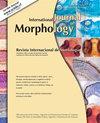Effect of Bimaxillary Orthognathic Surgery on Pharyngeal Airway Volume
IF 0.5
4区 医学
Q4 ANATOMY & MORPHOLOGY
引用次数: 0
Abstract
Subjects with maxillary skeletal classes II and III not only express alterations in the hard and soft maxillofacial tissues, but also in the morphology and dimensions of the upper airway. A small space in the upper airway has been associated with sleep disorders, such as snoring and mainly obstructive sleep apnea/hypopnea syndrome (OSAHS). Consequently, interest has increased due to the influence of orthognathic surgery in the airway space. Although there are studies in the literature that have compared upper airway spaces, most have evaluated the changes using two-dimensional images, mainly lateral skull X-rays. The present study aimed to determine the airway volume in subjects with skeletal classes II and III who underwent bimaxillary orthognathic surgery. 80 CBCT exams from 40 subjects obtained before and 6 months after surgery were used. There were 20 class II and 20 class III subjects. For the volumetric analysis, a 3D rendering of the upper airway was made in previously established segments, and then the airway volume was calculated using the 3D Slicer® software version 4.11 (Slicer, USA). The statistical analysis by t-test of related samples revealed statistically significant volumetric increases in the nasopharynx, laryngopharynx, and total volume in class II patients. However, in class III patients, there were significant increases in the nasopharynx and total volume, while the volume was maintained in the oropharynx and laryngopharynx.双颌正颌手术对咽气道容积的影响
上颌骨骼II类和III类的受试者不仅表现出颌面部软硬组织的改变,而且表现出上呼吸道形态和尺寸的改变。上呼吸道的小空间与睡眠障碍有关,如打鼾,主要是阻塞性睡眠呼吸暂停/低通气综合征(OSAHS)。因此,由于正颌手术对气道间隙的影响,兴趣增加了。虽然文献中有比较上呼吸道空间的研究,但大多数研究都是使用二维图像(主要是侧颅骨x射线)来评估变化。本研究旨在确定II类和III类骨骼患者接受双颌正颌手术后的气道容积。采用40例患者术前及术后6个月的80份CBCT检查结果。II类受试者20名,III类受试者20名。为了进行体积分析,在先前建立的段中对上气道进行3D渲染,然后使用3D Slicer®软件版本4.11 (Slicer,美国)计算气道体积。相关样本的t检验统计分析显示,II类患者鼻咽部、喉咽部和总容积均有统计学意义的增加。然而,在III类患者中,鼻咽部和总容积明显增加,而口咽部和喉咽部的容积保持不变。
本文章由计算机程序翻译,如有差异,请以英文原文为准。
求助全文
约1分钟内获得全文
求助全文
来源期刊

International Journal of Morphology
ANATOMY & MORPHOLOGY-
CiteScore
0.90
自引率
20.00%
发文量
110
审稿时长
3-8 weeks
期刊介绍:
The International Journal of Morphology (Revista Internacional de Morfología) (Print ISSN 0717-9367; Online ISSN 0717-9502) is an official publication of the Chilean Society of Anatomy, Argentine Association of Anatomy and Panamerican Association of Anatomy. It is the continuation of Revista Chilena de Anatomía (Chilean Anatomical Journal) and is published bimonthly. The six issues published yearly constitute one volume. This journal covers morphology in all its aspects, Gross Anatomy, Histology and Developmental Biology, as well as human and animals morphological aspects, including Celular, Molecular, systems or Evolutionary Biology. Reviews, short and brief communications and Letters to the Editor are also accepted.
 求助内容:
求助内容: 应助结果提醒方式:
应助结果提醒方式:


